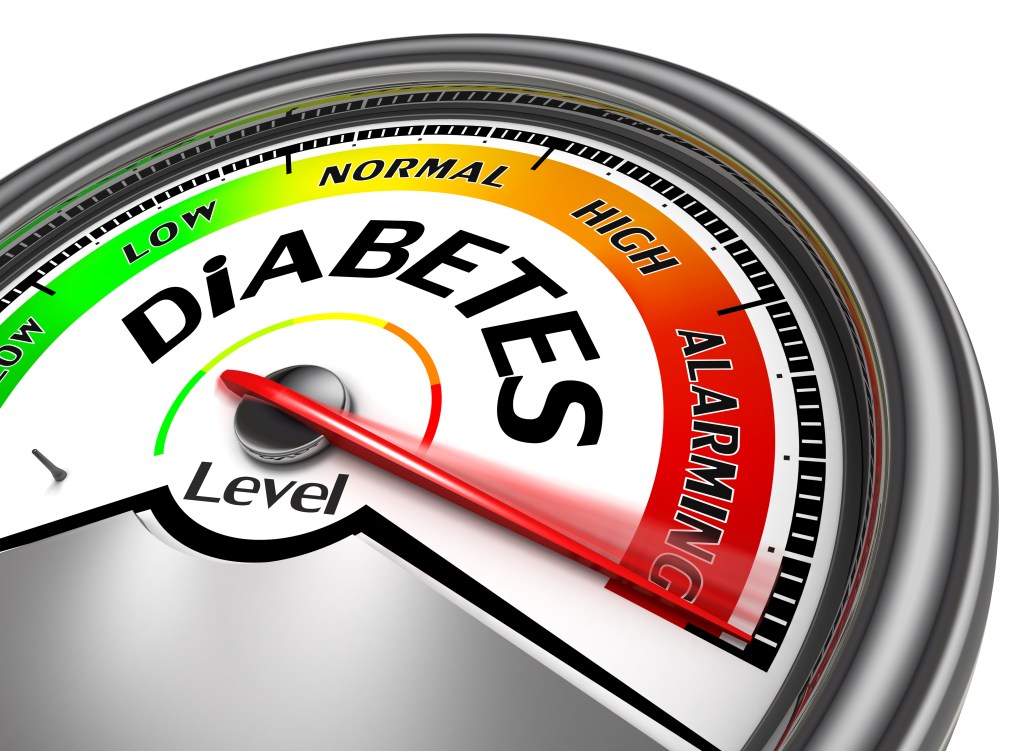At a glance
Diabetes is a chronic metabolic disorder driven by insulin resistance and elevated blood sugar levels. However, with the right dietary and lifestyle changes, blood sugar balance and metabolic functions can be restored. A low-carb, nutrient-rich diet combined with intermittent fasting is an excellent approach to enhance insulin sensitivity and help reverse diabetes.
Diabetes develops as a result of poor blood sugar control, which can have serious health consequences, including vision loss, kidney problems, heart disease, and nerve damage.
However, diabetes can be managed and even reversed by making beneficial dietary and lifestyle changes.
Here’s the ultimate diabetes nutrition guide to promote balanced blood glucose levels and restore metabolic health.
What is diabetes?
Diabetes is a serious metabolic imbalance characterized by insulin resistance and loss of blood sugar control, resulting in chronically elevated blood glucose levels.
Type 2 diabetes is the most widespread form, typically linked to a diet high in refined carbohydrates, sugars, trans fats, and processed foods.
According to data published by the American Diabetes Association (ADA), more than 38 million U.S. adults have diabetes, which represents 11.6 percent of the total population.1
Diabetes can have serious health consequences. Prolonged periods of high blood glucose levels, also known as hyperglycemia, can lead to inflammation, hormonal imbalances, nerve damage, vision loss, and heart disease.
Research published in Cardiovascular Diagnosis and Therapy found that diabetes is a significant risk factor for cardiovascular disease, which may explain why people with diabetes are at an increased risk of premature death.2
Watch the video below to discover the number one nutrient to manage diabetes.
Symptoms of diabetes
Unfortunately, diabetes is a silent disease, and most people don’t know they have diabetes until they develop serious health issues.
There are very few early warning signs of hyperglycemia, and as blood sugar regulation worsens into prediabetes and diabetes, various physiological processes can be affected.
Here are common symptoms of diabetes:
- Excessive thirst and urination
- Darkened skin on neck, armpits, and groin
- Increased hunger and cravings
- Poor memory
- Numbness in the feet or hands
- Fatigue
- Vision problems
- Frequent infections
- Unexplained changes in weight
- Poor wound healing

What causes diabetes?
Most cases of diabetes are linked to unhealthy dietary habits and a sedentary lifestyle.
Consuming sugars, refined grains, and starches, such as bread, pasta, and white rice, can cause rapid blood sugar spikes, which trigger the release of large amounts of insulin. This metabolic hormone regulates blood sugar levels and promotes fat storage.
Over time, elevated insulin levels can decrease cellular sensitivity to insulin, a condition known as insulin resistance. This diminishes the body’s ability to control blood sugar levels and is the leading cause of diabetes.
In addition to a high-carb diet, a lack of physical activity poses another significant risk factor for insulin resistance and diabetes.
A sedentary lifestyle correlates with poor metabolic health and accumulation of belly fat, which is metabolically active and releases various substances that can interfere with the body’s ability to regulate insulin properly.
Research published in the International Journal of Clinical Practice investigated the link between obesity and diabetes and concluded, “There is a strong association between abdominal obesity and the development of type 2 diabetes.”3
According to data published by the National Institute of Diabetes and Digestive and Kidney Diseases (NIDDK), certain populations are at an increased risk of diabetes due to a complex interplay of genetics, cultural dietary patterns, and socioeconomic factors.4
Ethnicities at increased risk of developing diabetes include:
- African Americans
- Hispanics
- Native Americans
- Pacific Islanders

Can diabetes be reversed?
Yes, diabetes can be reversed. Unfortunately, only around two percent of diabetes patients achieve remission, which indicates that current diabetes management protocols don’t address the root causes.
Standard treatment combines blood sugar-lowering drugs such as metformin with diabetic diet recommendations focusing on healthy carbohydrates and low saturated fat intake. However, research has long refuted the benefits of this dietary pattern for diabetes care.
Evidence published in Frontiers in Nutrition highlighted that limiting all carbohydrates appears to be a superior dietary approach to managing, preventing, and reversing diabetes.5
“Insulin resistance is directly related to a high-carbohydrate diet,” explains Dr. Berg. “Restricting carbs is one of the most critical steps in restoring blood sugar and insulin balance.”

Foods to avoid if you have diabetes
Because diabetes is linked to chronically elevated blood sugar levels, it’s crucial to avoid carbohydrate-rich foods, including grains, cereals, starches, and sugary foods.
Here are common foods high in carbs you should avoid if you have diabetes:
- Bread, pastry, cakes, crackers
- Flour, rice, pasta
- Sugars, honey, syrups
- Candy, ice-cream, desserts
- Sweetened yogurts
- Cereals, cereal bars
- Processed snack foods
- Fast food
- Legumes
- Fruits
- Sugar-containing sauces and condiments
Many food products contain hidden carbs, and it’s crucial to check the total carbohydrate count on food labels to identify foods that can spike blood sugar levels and contribute to insulin resistance.
Many soft drinks and sodas are packed with sugars, so avoiding these beverages is vital. Instead, opt for water, herbal teas, or unsweetened iced tea to minimize carb intake.

Best nutrients for diabetes
In addition to following a low-carb diet, it’s vital to consume plenty of healthy foods rich in essential vitamins, minerals, and fatty acids.
Optimal blood sugar control requires various nutrients, and nutritional deficiencies can increase the risk of insulin resistance and diabetes.
Here are four of the best nutrients to incorporate into a low-carb diabetes diet.
1. Potassium
Potassium is an essential electrolyte that has been found to enhance insulin sensitivity and improve blood sugar control.
In addition, potassium plays a crucial role in kidney function and may help prevent diabetes-related kidney damage, also known as diabetic nephropathy.
Potassium-rich food sources include avocado, spinach, salmon, Brussels sprouts, and broccoli.
2. Magnesium
Magnesium is another vital electrolyte needed for proper blood sugar control.
Several enzymes involved in glucose transport and metabolism require magnesium, which explains why magnesium deficiency can increase the risk of hyperglycemia.
Some of the best magnesium-rich foods include leafy green vegetables, seeds, nuts, dark chocolate, and avocado.
3. Chromium
Research published in Diabetes and Metabolism found that chromium has various health benefits for diabetic individuals.6
Chromium promotes insulin sensitivity, thereby lowering the need for insulin, which is linked to better metabolic health and a lower risk of diabetes.
Consuming plenty of chromium-rich foods such as eggs, seafood, mushrooms, nuts, broccoli, and green beans as part of a balanced diet is an excellent strategy to support balanced blood sugar and insulin levels.
4. Omega-3 fatty acids
Omega-3 fatty acids have potent anti-inflammatory properties, which help mitigate the detrimental effects of hyperglycemia on cardiovascular function.
Consuming plenty of omega-3 fats while limiting pro-inflammatory trans fats can reduce the risk of heart disease and promote overall metabolic balance in diabetic individuals.
Cod liver oil, flaxseeds, chia seeds, and oily fish such as salmon, tuna, and sardines are among the best dietary sources of heart-health-promoting omega-3 fats.

Benefits of intermittent fasting for diabetes
Intermittent fasting is an eating pattern characterized by alternating between periods of fasting and time-restricted eating windows.
The 16:8 fasting method is a popular type of intermittent fast that entails fasting for 16 hours followed by an eight-hour eating period.
Caloric restriction during fasting periods forces the body to utilize body fat to generate energy. This metabolic switch to burning fat instead of relying on sugar as a fuel source has profound health benefits, including weight loss, enhanced insulin resistance, and stable blood sugar levels.
A recent clinical trial published in The Journal of Clinical Endocrinology and Metabolism found that three months of intermittent fasting resulted in complete diabetes remission in half of the study participants.7
The metabolic benefits of time-restricted eating can be amplified by combining intermittent fasting with a nutritious low-carb diet like Healthy Keto®.
Consuming nutrient-rich whole foods while restricting carb intake is an ideal meal plan for individuals with poor metabolic health, including those with prediabetes and diabetes.
Research published in Cureus confirms the benefits of keto for diabetes and suggests that “The ketogenic diet is superior to other dietary approaches, and the results are significant enough to recommend it as an adjunctive treatment for type two diabetes.”8

How to start Healthy Keto and Intermittent Fasting
While getting started with Healthy Keto and intermittent fasting may seem challenging, there are plenty of keto hacks and resources to help you succeed.
Healthy Keto focuses on limiting carbohydrates to between 20 and 50 grams daily while obtaining the majority of calories from healthy fats.
This healthy meal plan also advocates the consumption of non-GMO vegetables, grass-fed beef, game meat, wild-caught fish, organic dairy, and pasture-raised eggs.
Eliminate high-carb and processed foods from your pantry, and instead, fill it with keto-friendly foods to have plenty of options to make healthy meals that are low in carbs.
If you have a sweet tooth, opt for keto-approved sweeteners such as monk fruit or stevia to satisfy cravings while staying in fat-burning mode.
It’s recommended to slowly transition into intermittent fasting to allow your body to adapt to the hormonal and metabolic changes of caloric restriction.
Many people start with 14 hours of fasting followed by a ten-hour eating window and gradually prolong their fasting periods until they reach a 16:8 intermittent fasting schedule.
Symptoms such as dehydration, fatigue, muscle cramps, headaches, and irritability are common during the early stages of adapting to fasting and a low-carb diet.
Drinking plenty of water and replenishing electrolytes–including potassium, sodium, calcium, and magnesium–can help prevent these symptoms.
Get your free beginner’s guide to Healthy Keto and intermittent fasting delivered straight into your inbox so you can make confident dietary choices that benefit your health and well-being.
Key takeaways
- Diabetes is a result of poor blood sugar control and insulin resistance, which are primarily linked to high-carb diets.
- Limiting carbohydrate intake and focusing on nutrient-dense, whole foods promotes better glucose balance, crucial for effective blood sugar control.
- Key nutrients such as potassium, magnesium, chromium, and omega-3 fatty acids support cellular insulin sensitivity and overall blood sugar balance.
- Intermittent fasting enhances fat burning and further improves blood sugar control.
- Combining Healthy Keto and intermittent fasting offers one of the most effective natural strategies for reversing diabetes.
FAQ
1. Can you reverse diabetes with a healthy diet?
Yes, it’s possible to reverse diabetes with a nutritious, low-carb diet.
Restricting carbohydrates helps promote balanced blood sugar levels and enhances insulin sensitivity, two crucial factors in restoring the body’s ability to regulate blood glucose and reverse diabetes.
2. What are the nutrients do diabetics need?
Diabetic individuals can promote metabolic health and support blood sugar control by increasing foods rich in potassium, magnesium, chromium, and omega-3 fatty acids.
In addition, vitamin D and zinc have been found to enhance insulin sensitivity, which plays a critical role in managing diabetes.
3. What foods should those with diabetes avoid?
Diabetics should avoid high-carb and sugary foods such as refined grains, sugar-sweetened beverages, sweets, and processed snacks.
In addition, it’s recommended to limit starches, such as white rice, flour, pasta, bread, and crackers, as these foods cause rapid blood sugar spikes, which contribute to insulin resistance and diabetes.
4. What are the best foods for reversing diabetes?
To improve blood sugar balance and reverse diabetes, it’s recommended to consume plenty of non-starchy vegetables, grass-fed beef, game meats, wild-caught fish, pasture-raised eggs, and full-fat organic dairy.
These foods don’t significantly spike blood sugar levels, which supports weight loss and helps restore cellular sensitivity to insulin.
5. Can fasting help with diabetes?
Yes, fasting is an excellent strategy to manage diabetes.
During fasting periods, the body is forced to utilize stored body fats instead of sugars to generate energy. This promotes weight loss, keeps blood sugar levels balanced, and can increase insulin sensitivity, all crucial aspects for effective diabetes management.
6. What’s the fastest way to reverse diabetes?
Following a nutritious low-carb diet such as Healthy Keto® in combination with intermittent fasting is an excellent strategy to promote metabolic balance.
Limiting carb intake and fasting has been shown to improve insulin resistance, which is critical to restoring blood sugar control and reversing diabetes.
7. How long does it take to reverse diabetes?
How long it takes to reverse diabetes depends on your overall health status, severity of diabetes, and your commitment to dietary and lifestyle changes.
While some individuals can reverse diabetes within three months of starting intermittent fasting and Healthy Keto, others may require up to six months to restore blood sugar control.
Sources
- https://diabetes.org/about-diabetes/statistics/about-diabetes ?
- https://pmc.ncbi.nlm.nih.gov/articles/PMC8319397/ ?
- https://pmc.ncbi.nlm.nih.gov/articles/PMC7641470/ ?
- https://www.niddk.nih.gov/health-information/diabetes/overview/what-is-diabetes/prediabetes-insulin-resistance ?
- https://pmc.ncbi.nlm.nih.gov/articles/PMC6511678/ ?
- https://citeseerx.ist.psu.edu/document?repid=rep1&type=pdf&doi=7ea0b8bd2f6e8fde00bbd1a416f4e362a0075d0d ?
- https://academic.oup.com/jcem/article-abstract/108/6/1415/6888005?redirectedFrom=fulltext&login=false ?
- https://pmc.ncbi.nlm.nih.gov/articles/PMC2658023/ ?








